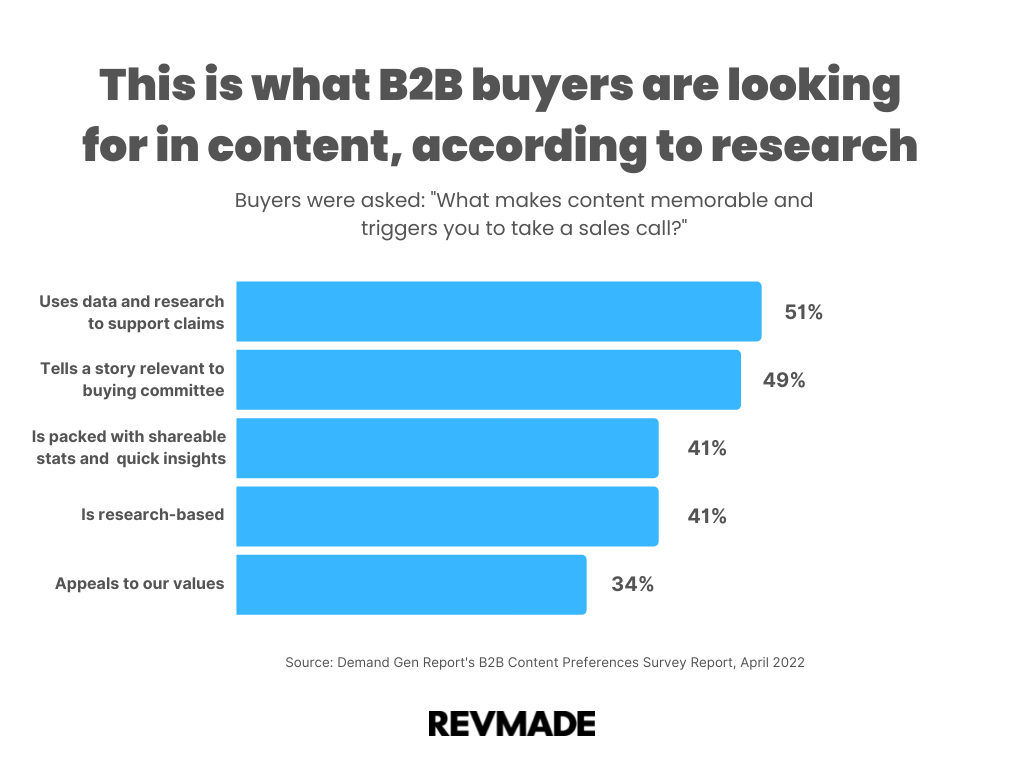This is what B2B buyers are looking for in content, according to research
B2B buyers spend a lot of time selling internally. Here’s how your content can help them – and you.We recently wrote about how COVID has changed B2B buying – and how decisions are slower because more vendors are being considered and more stakeholders are weighing in. This obviously hurts sellers themselves (78% report it’s more difficult to get buy-in on sales… ugh) but that pain extends to the buyers too, who are forced to shepherd an internal sales and deliberation process that can drag out for months.
Our job is to make our buyers’ lives easier to pave the path toward a sale (55% of buyers report they now rely more on content to make purchasing decisions than they did a year ago).
So what do buyers need to sell internally first? We reviewed the 2022 Content Preferences Survey Report from DemandGen Report to understand what content actually helps B2B buyers sell a specific company and approach to their colleagues:

Use data in the context of their problem.
Anyone can use surface-level stats to bolster an argument about why they are the best vendor. And that’s the problem.
This report (and our experience) argues that thoughtful, unique research about how to approach and solve the buyer’s problem is the most effective way to get into a productive conversation with a buyer.
Think about it this way: If you were a team of analysts deployed to understand and solve the buyer’s problem, wouldn’t you have an easier time getting a meeting? And wouldn’t the conversation you had in that meeting be more helpful to you and them than a canned sales pitch?
Your product can be the ultimate answer to their challenge. But the smartest B2B marketers know you have to prove you really understand their problem and have a thoughtful approach that helps them before you ask for the sale.
Help them tell a strong story that resonates with the buying committee.
Forty-nine percent (49%) of respondents said companies need to tell a story that resonates with the buying committee before they’ll agree to a meeting.
Stories that work are meaningful and memorable. The way to do that is to understand the core problem, acknowledge the pain of it, and reassure that it can be solved.
Case studies are a good start, but they often lack narrative and are therefore forgettable. As a marketer, your challenge is to understand the “From / To” that your product or service delivers, making sure to include memorable characters (executives like the ones you are speaking with), conflict (a human problem that resonates) and resolution (how your product solved the human problem).
Get to the point.
Forty-one percent (41%) of buyers said content that’s “packed with shareable stats and quick-hitting insights” would encourage them to take a call.
Insights – proving you understand the problem and have unique ways to approach a solution – have to respect the buyer’s time. Insights have real value, but the buyer needs to understand you won’t also waste precious time getting to the point.
Putting the lens of time-saving across all of this advice through easy to understand, dynamic formats (highly visual graphics and data points, easy-to-digest case studies that tell a story, instructive videos that address how to solve a problem, not just that it’s been solved) will help convey to your buyers that you can be effective while respecting their time above all else.
TLDR: Smart marketers develop content that helps their buyer envision not only how they’d deploy it for success, but also, crucially, how they’ll sell the solution to a growing number of internal stakeholders.
Subscribe
Get our weekly newsletter for tips on how to drive better content marketing performance.
For a regular stream of ideas, research and links we find helpful. And of course, to say hi!
